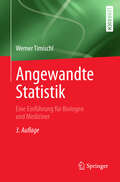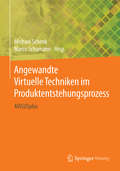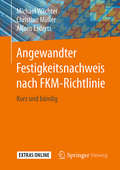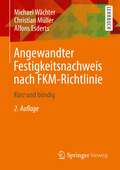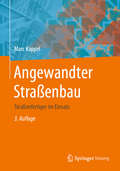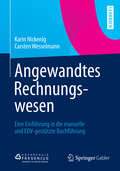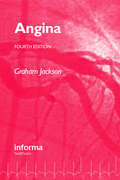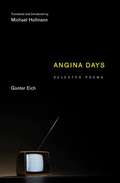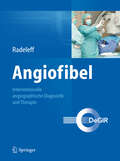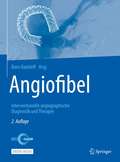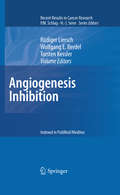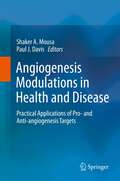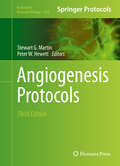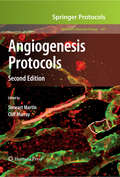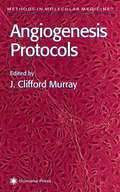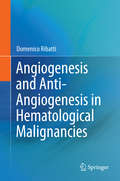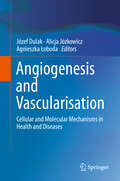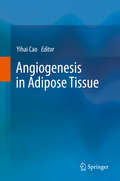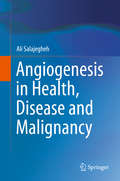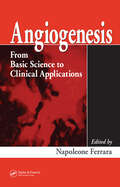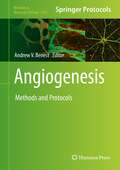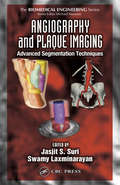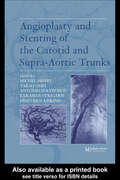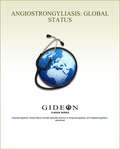- Table View
- List View
Angewandte Statistik: Eine Einführung für Biologen und Mediziner
by Werner TimischlDie "Angewandte Statistik" ist ein Lehr- und Übungsbuch für Anwenderinnen und Anwender der Statistik, die ein Verständnis für statistische Methoden und eine Sicherheit in der Anwendung dieser Methoden erwerben wollen. Vorausgesetzt wird nur die Kenntnis der für den Universtäts- oder Fachhochschulzugang erforderlichen Schulmathematik. Das Lehrbuch führt zuerst in die Wahrscheinlichkeitsrechnung ein und stellt grundlegende Wahrscheinlichkeitsverteilungen vor. Ausführlich werden die Parameterschätzung und das Testen von Hypothesen behandelt. Mit den gängigen Korrelationsmaßen und ausgewählten Regressionsmodellen wird die statistische Grundbildung abgerundet. Die Kapitel über varianzanalytische Modelle und multivariate Verfahren geben einen Einblick in zwei weitere, für die statistische Praxis relevante Gebiete. Darüber hinaus werden Vertiefungen und spezielle Anwendungen in ergänzenden Abschnitten bereitgestellt. Zahlreiche, vollständig durchgerechnete Beispiele und Übungsaufgaben mit einem ausführlichen Lösungsteil machen die "Angewandte Statistik" zu einem Arbeitsbuch, das sich auch zum Selbststudium eignet. Die Ausrichtung auf die Statistik-Software R (durch Verweise auf die entsprechenden R-Funktionen und die Angabe des R-Codes bei den Lösungen der Aufgaben) trägt der Bedeutung computerunterstützter Problemlösungen in der statistischen Praxis Rechnung.
Angewandte Virtuelle Techniken im Produktentstehungsprozess: AVILUSplus
by Michael Schenk Marco SchumannDieses Buch beschreibt die Forschungsergebnisse des Projektes AVILUSplus. Die Wissenschaftler befassen sich mit den Technologieentwicklungen zur Erh#65533;hung der Realit#65533;tsn#65533;he virtueller Modelle. Dazu werden f#65533;nf Themenschwerpunkte betrachtet: Informationsmanagement im Produktlebenszyklus, Simulation und Rendering, Tracking, Interaktion und Geometrieerfassung. Das Buch richtet sich an Wissenschaftler und Technologieentwickler, die sich #65533;ber den aktuellen Stand, Entwicklungstrends und Einsatzm#65533;glichkeiten virtueller Techniken informieren m#65533;chten. Umfangreiche Referenzen liefern einen Ausblick auf weiterf#65533;hrende Arbeiten.
Angewandter Festigkeitsnachweis nach FKM-Richtlinie: Kurz und bündig
by Christian Müller Michael Wächter Alfons EsdertsDieses Fachbuch unterst#65533;tzt nachhaltig bei der Durchf#65533;hrung von rechnerischen Festigkeitsnachweisen mit der FKM-Richtlinie ,,Rechnerischer Festigkeitsnachweis". Es behandelt den Festigkeitsnachweis mit einigen Einschr#65533;nkungen, die jedoch f#65533;r viele Anwendungsf#65533;lle ausreichend sind und reduziert damit den Umfang der Richtlinie auf die wesentlichen Aspekte. Der prinzipielle Ablauf eines Festigkeitsnachweises wird anhand von praxisrelevanten Beispielen erl#65533;utert, die vom Leser parallel nachvollzogen werden k#65533;nnen. Bei den Beispielen bildet die Ermittlung der #65533;rtlichen elastizit#65533;tstheoretischen Spannungen mit der Software ANSYS Workbench einen #65533;ber die Richtlinie hinausgehenden Bestandteil. Auf der Verlagsseite im Internet finden sich CAD- und FE-Modelle f#65533;r die Beispiele sowie weitere Zusatzinformationen wie Berechnungsskripte f#65533;r die lineare Schadensakkumulation nach dem Verfahren Miner konsequent.
Angewandter Festigkeitsnachweis nach FKM-Richtlinie: Kurz und bündig
by Christian Müller Michael Wächter Alfons EsdertsDieses Lehrbuch unterstützt nachhaltig bei der Durchführung von rechnerischen Festigkeitsnachweisen mit der 7. Ausgabe der FKM-Richtlinie „Rechnerischer Festigkeitsnachweis für Maschinenbauteile“ von 2020. Es erläutert den Berechnungsablauf, wie er in der FKM-Richtlinie beschrieben ist, wobei auf die Darstellung diverser Spezialfälle verzichtet wird. Dieser reduzierte Ablauf erleichtert das Verständnis und ist für viele Anwendungsfälle dennoch ausreichend. Der Ablauf eines Festigkeitsnachweises wird anhand von praxisrelevanten Beispielen erläutert, die vom Leser nachvollzogen und nachgerechnet werden können. Bei den Beispielen bildet die Ermittlung der örtlichen elastizitätstheoretischen Spannungen mit der Finite-Elemente-Software ANSYS Workbench einen über die Richtlinie hinausgehenden Bestandteil. Mithilfe des umfangreichen Zusatzmaterials, das im Internet zum Download bereitsteht, können die Finite-Elemente-Berechnungen für die Spannungsermittlung sowie die lineare Schadensakkumulation mit dem Verfahren Miner konsequent nachvollzogen werden.
Angewandter Straßenbau: Straßenfertiger im Einsatz
by Marc KappelAnschaulich werden die verschiedenen Verfahrens- und Arbeitstechniken im Straßenbau erklärt. Der Schwerpunkt liegt dabei auf dem Einsatz von Straßenfertigern im Oberbau. Es wird systematisch beschrieben, worauf es bei der Planung und Durchführung eines Straßenbauprojektes ankommt. An elf Beispielbaustellen wird mit handfesten Hinweisen und praktischen Tipps erklärt, wie der Oberbau einer Straße erstellt wird. Es werden zudem die theoretischen Grundlagen vermittelt sowie neueste Erkenntnisse der Forschung und Entwicklung vorgestellt. Dabei stehen vor allem die zunehmende Digitalisierung im Straßenbau, der Einfluss von Industrie 4.0 und BIM im Vordergrund.
Angewandtes Rechnungswesen: Eine Einführung in die manuelle und EDV-gestützte Buchführung
by Karin Nickenig Carsten WesselmannEingängig und praxisnah vermittelt dieses Lehrbuch das bei Lernenden oft unbeliebte Rechnungswesen, das die Basis unternehmerischer Entscheidungen bildet. Eine durchgängige Fallstudie führt anhand systematisch aufgebauter Lerneinheiten in alle gesetzlichen und organisatorischen Grundlagen der Buchführung ein und erläutert weiterführende Themen wie Abschreibungen, Rückstellungen oder Rechnungsabgrenzungen. Zahlreiche Beispiele, Schaubilder, Konten- und Buchungslisten veranschaulichen die Lerninhalte. Umfangreiche Übungsaufgaben in Anlehnung an praxisnahe Klausuren unterstützen die Selbstkontrolle und bereiten Lernende auf reale Prüfungsanforderungen vor. Speziell zum Werk wurde mit der Buhl Data GmbH eine Schulungsversion des Programms WISO Buchhaltung entwickelt, mit dem die Leser ihr Wissen parallel am Computer erproben und festigen können. Dadurch erhalten die Lernenden einen schnellen und praxisnahen Einblick in die EDV-gestützte Buchführung, die heute aus dem Arbeitsalltag nicht mehr wegzudenken ist.
Angeze sakghona ukudlala soke
by African Storybook TRANSLATED BY Sponono MahlanguIsindebele – First Paragraphs
Angina
by Graham JacksonThis fourth edition of Angina has been extensively revised and expanded with regard to the increasing importance of managing hyperlipidemia, diagnosing and treating coronary artery disease in women and the elderly, and managing chest pain in the presence of normal coronary arteries. Additionally, the roles of medicine, percutaneous coronary interve
Angina Days
by Günter EichThis is the most comprehensive English translation of the work of Günter Eich, one of the greatest postwar German poets. The author of the POW poem "Inventory," among one of the most famous lyrics in the German language, Eich was rivaled only by Paul Celan as the leading poet in the generation after Gottfried Benn and Bertolt Brecht. Expertly translated and introduced by Michael Hofmann, this collection gathers eighty poems, many drawn from Eich's later work and most of them translated here for the first time. The volume also includes the original German texts on facing pages. As an early member of "Gruppe 47" (from which Günter Grass and Heinrich Böll later shot to prominence), Eich (1907-72) was at the vanguard of an effort to restore German as a language for poetry after the vitriol, propaganda, and lies of the Third Reich. Short and clear, these are timeless poems in which the ominousness of fairy tales meets the delicacy and suggestiveness of Far Eastern poetry. In his late poems, he writes frequently, movingly, and often wryly of infirmity and illness. "To my mind," Hofmann writes, "there's something in Eich of Paul Klee's pictures: both are homemade, modest in scale, immediately delightful, inventive, cogent." Unjustly neglected in English, Eich finds his ideal translator here.
Angiofibel: Interventionelle angiographische Diagnostik und Therapie
by Boris A. RadeleffInterventionelle Radiologie Schritt für Schritt Jede Intervention stellt den behandelnden Arzt vor wichtige Fragen: Was ist bei der Patientenaufklärung zu beachten?Welche Materialien sind für diesen speziellen Fall am besten geeignet?Welches ist das optimale Vorgehen?Welche Fallstricke gibt es?Die passenden Antworten gibt das vorliegende Buch. Der Leser erfährt alles Wichtige für seine tägliche Arbeit in der Interventionellen Radiologie (vaskuläre und nicht-vaskuläre, onkologische und Notfalleingriffe). Praktische Handlungsanweisungen und Hinweise zur Vermeidung von Komplikationen runden das als Werkzeug in der täglichen Routine gedachte Werk ab. Viele praktische Tipps erleichtern den Klinikalltag Detaillierte Informationen zu Indikationsstellung und KontraindikationenPatientenvorbereitungAuswahl der erforderlichen MaterialienMethodik des EingriffesMedikamentöse peri- und postinterventionelle TherapieKlinische ErgebnisseKomplikationenAuch der fortgeschrittene Interventionalist findet in diesem Buch viel Neues zur Verfeinerung der Techniken.
Angiofibel: Interventionelle angiographische Diagnostik und Therapie
by Boris RadeleffAngiofibel 2.0 - mit Online-CasesEin detailliertes, vollständig überarbeitetes und erweitertes Arbeitsbuch: unverzichtbar für alle angiographischen Eingriffe, nicht nur für Interventionelle Radiologen, sondern auch fachübergreifend für Gefäßchirurgen, sowie Gastroenterologen.Neue Online-Features in der 2. Auflage:eBook Inside: Downloadcode im Innenteil des Buches für das eBook auf www.springer.com enthalten (kostenlose Registrierung erforderlich)Videos per App: Laden Sie die SpringerNature MoreMedia herunter - Abbildungen im Buch per App mit Handy oder Tablet scannen, um Videos zu streamenPraktische Handlungsanweisungen und Bildbeispiele sowie Hinweise zur Vermeidung und Management von Komplikationen runden das als Arbeitswerkzeug in der täglichen Routine gedachte Werk ab. Neue und erweiterte Kapitel:Notfall Gefäßembolisation: Interkostal-, Lumbalarterie und A. epigastrica inf.Embolisation gynäkologischer Tumor-BlutungenEmbolisation von pulmonalen AV-Fisteln (PAVM)Onkologische EmbolisationTransvaskuläre Therapie der LebermetastasencTACE bei CRM-MetsDEB-TACE bei CRM-MetsIsolierte Chemosaturation (Delcath)Transarterielle Therapie bei CCCTransarterielle Therapie bei neuroendokrinen Karzinommetastasen (MNET)Diagnostik, Klassifikation und Therapie von GefäßanomalienEmbolisation benigner Lebertumore (z.B. FNH)MilzembolisationProstataembolisation
Angiogenesis Inhibition (Recent Results in Cancer Research #180)
by Torsten Kessler Wolfgang E. Berdel Rüdiger LierschAngiogenesis is attracting increased scientific and clinical interest. The identification of novel mediators and targeting molecules has led to significant progress in our understanding of tumor angiogenesis and tumor vessel targeting. Important advances in cancer treatment have already emerged, and in the future, blood vessel targeting will play a significant role within individualized therapeutic strategies. This volume provides a general overview of the latest developments in angiogenesis inhibition in cancer. All aspects from the bench to the bedside are considered, with detailed attention both to basic research and to its translation into clinical practice. Individual chapters are devoted to the roles of angiopoietins, HIF-1a, chemokines, PDGF and VEGF, and vascular integrins. The latest results of clinical trials are presented, and various advanced targeting strategies are discussed. This book will be invaluable to all who wish to learn of the most recent advances in this exciting field.
Angiogenesis Modulations in Health and Disease: Practical Applications of Pro- and Anti-angiogenesis Targets
by Shaker A. Mousa Paul J. DavisThis book is a major update of novel targets in angiogenesis modulation, including pro- and anti-angiogenesis. There is in-depth coverage of preclinical and clinical methods and models, investigational status, and clinical applications. The impact of nanotechnology in advancing the applications of pro-and anti-angiogenesis strategies is also highlighted, along with stem cell and biotechnologies in research and development of angiogenesis modulating targets.
Angiogenesis Protocols (Methods in Molecular Biology #1430)
by Stewart G. Martin Peter W. HewettInaddition to updating important core techniques this third edition presents newchapters on assessing leukocyte involvement in angiogenesis, lymphatic cell andpericyte isolation techniques, spheroid and arterial ring based in vitroassays, and on pericyte involvement in angiogenesis. Angiogenesis Protocols,Third Edition also guides readers through new protocols on chorioallantoicmembrane models, corneal pocket assays to assess angio- and lymphangiogenesis,models of muscle angiogenesis, and use of zebrafish embryos to study vascularangiogenesis and senescence. Written in the highly successful Methods inMolecular Biology series format, chapters include introductions to theirrespective topics, lists of the necessary materials and reagents, step-by-step,readily reproducible laboratory protocols, and tips on troubleshooting andavoiding known pitfalls. Authoritativeand practical, Angiogenesis Protocols, Third Edition provides not only apractical handbook for key techniques, but also an informative and enjoyableread for all those interested, no matter how directly, in angiogenesis.
Angiogenesis Protocols (Methods in Molecular Biology #467)
by Cliff Murray Stewart MartinAs experimentation and clinical trials with first generation anti-angiogenic agents have yielded results and our understanding of the biology and physiology of blood and lymphatic vessels has increased, a new angiogenesis volume swiftly became a necessity. Angiogenesis Protocols, Second Edition remains true to its original vision of providing a single source for angiogenesis researchers, irrespective of levels of resource and expertise, by collecting a range of methods for cell isolation and assessing angiogenesis in vivo or in vitro. This information, however, is expanded to include chapters on circulating endothelial progenitor cells, angiogenic signalling pathways, imaging of angiogenesis, and measurement of tissue blood flow. Written in the Methods in Molecular BiologyTM series format, the chapters provide step-by-step laboratory protocols, lists of necessary materials and reagents, and a Notes section, which details tips on troubleshooting and avoiding known pitfalls. Extensive and cutting-edge, Angiogenesis Protocols, Second Edition is not only a practical handbook for key techniques, but also an informative and enjoyable read for all those interested, no matter how directly, in angiogenesis.
Angiogenesis Protocols (Methods in Molecular Medicine #46)
by J. Clifford MurrayA comprehensive collection of key techniques for assessing the formation of new blood vessels in both whole tissues and cell culture. These readily reproducible methods range from low-cost in vitro assays to cutting-edge in vivo models, such as the dorsal window chamber, which demands high levels of surgical skill as well as relatively expensive, custom-made equipment. Timely and highly practical, Angiogenesis Protocols is a gold-standard resource for today's angiogenesis investigator, providing easy access to a wide variety of proven assays suitable for laboratories with greatly differing technical expertise, materials, and financial resources.
Angiogenesis and Anti-Angiogenesis in Hematological Malignancies
by Domenico RibattiIt has been generally accepted that angiogenesis is involved in the pathogenesis of hematological malignancies, like acute and chronic leukemia, lymphoma, myelodysplastic syndromes, myeloproliferative neoplasms and multiple myeloma. The extent of angiogenesis in the bone marrow has been correlated with disease burden, prognosis and treatment outcome. Reciprocal positive and negative interactions between tumor cells and bone marrow stromal cells, namely hematopoietic stem cells, fibroblasts, osteoblasts/osteoclasts, endothelial cells, endothelial progenitor cells, T cells, macrophages and mast cells, mediated by an array of cytokines, receptors and adhesion molecules, modulate the angiogenic response in hematological tumors. More recently, it has been emphasized the pro-angiogenic role of the so called "vascular niche", indicating a site rich in blood vessels where endothelial cells and mural cells such as pericytes and smooth muscle cells create a microenvironment that affects the behavior of several stem and progenitor cells, in hematological malignancies.
Angiogenesis and Vascularisation: Cellular and Molecular Mechanisms in Health and Diseases
by Józef Dulak Alicja Józkowicz Agnieszka ŁobodaThe book presents the overview of the current knowledge in some fields of vascular biology, addressing cellular and molecular aspects of blood-vessel formation and their role in health and disease. The major factors involved in the formation of blood vessels are presented by scientists actively involved in this area of research. Special emphasis is put on the presentation of various molecular mechanisms not addressed in similar works to date. The book is divided into three parts. The first part describes the cells and mediators in angiogenesis. The significance of various populations of potential endothelial progenitors is particularly highlighted. The chapters of the second part focus on molecular mechanisms, with special emphasis on the role of hypoxia, gasotransmitters and reactive oxygen species as well as microRNAs in regulation of angiogenic processes. In the third part, the pathological aspects of disturbed - aggravated or impaired - vascularization are discussed and new modalities for potential therapies are presented. The book is intended for scientists and PhD students in the fields of vascular biology and cancer research. It may be of interest for medical professionals in the fields of cardiovascular disease, diabetes, oncology and rheumatoid arthritis.
Angiogenesis in Adipose Tissue
by Yihai CaoAngiogenesis has recently played a critical role in regulation of adipose tissue expansion and regression. Like most other tissues in the body, adipose expansion and regression is accompanied by alteration of blood vessel density and structures. The vascular alteration plays an active role in regulation of adipose tissue size and functions. Targeting blood vessels in the adipose tissue have demonstrated to be a novel approach for possibly treatment of cancer, obesity and other metabolic diseases. This book provides the most updated information on this type research and discusses future opportunities for therapy..
Angiogenesis in Health, Disease and Malignancy
by Ali SalajeghehThis book is about "Angiogenesis". A process in which new vasculature is formed from pre-existing capillaries. Angiogenesis process is associated with the proliferation and growth of both physiologically normal and neoplastic tissues, through the formation of vascular supply, essential for delivering growth requirements such as oxygen and nutrients. The book describes more than 100 genes and their key regulatory functions in the context of normal healthy condition, disease and malignancy, cancer proliferation and progression. New insights into the role of angiogenesis and the therapeutic inhibition of its regulators are investigated, due to the great potential for exploitation in the development of a novel treatment for cancer. New scientists, junior researchers and biomedical science students will find this book an invaluable introductory reference to their insight about angiogenesis and angiogenic role of more than 100 angiogenes and their role in healthy, disease and malignant conditions.
Angiogenesis: From Basic Science to Clinical Applications
by Napoleone FerraraWhy a new book on angiogenesis and why now? For the first time concepts proposed over 30 years ago have found clinical validation. In the last two years the first antiangiogenic agents have been approved by the FDA for the treatment of cancer and age-related macular degeneration. Not surprisingly, this clinical success has raised a new set of basic
Angiogenesis: Methods and Protocols (Methods in Molecular Biology #2441)
by Andrew V. BenestThis detailed book builds on the foundation of lymphatic protocols with tools to aid in the interpretation of large datasets created by angiogenesis research. For example, this includes protocols to explore how transcriptional phenotyping can be achieved, both in terms of exploring tissue-specific heterogeneity to the use of database mining of existing datasets. Similarly, bioinformatic techniques run alongside protocols for transcript analysis, cell biology, pathology, as well as physiological and developmental angiogenesis models. Written for the highly successful Methods in Molecular Biology series, chapters include introductions to their respective topics, lists of the necessary materials and reagents, step-by-step, readily reproducible laboratory protocols, and tips on troubleshooting and avoiding known pitfalls. Authoritative and up-to-date, Angiogenesis: Methods and Protocols provides a meaningful compendium of practical approaches to angiogenesis and endothelial cell biology research.
Angiography and Plaque Imaging: Advanced Segmentation Techniques (Biomedical Engineering Ser.)
by Jasjit S. Suri Swamy LaxminarayanRecent, rapid advances in mathematical engineering and applied mathematics have opened the door to solving complex problems in angiography imaging. For the first time, this book presents the different medical imaging modalities--MR, CT, x-ray, and ultrasound--for performing angiography and its analysis. Pioneers from a variety of relevant disciplin
Angioplasty and Stenting of Carotid and Supra-aortic Trunks
by Michel Henry Dimitrios Kiskinis Takao Ohki Kyriakos Strigaris Antonio Polydorou Chief PatronAlthough carotid endarectomy (CEA) has long been considered the gold standard technique, recent studies report that short- and long-term results with carotid angioplasty and stenting(CAS) are comparable to those with CEA in a significant number of cases. Covering clinical assessment, techniques and devices, medical treatment, and more, Angioplasty
Angiostrongyliasis: Global Status 2010 edition
by Dr Stephen Berger Gideon InformaticsAngiostrongyliasis: Global Status is one in a series of GIDEON ebooks which summarize the status of individual infectious diseases, in every country of the world. Data are based on the GIDEON database (www.gideononline.com) which relies on standard text books, peer-review journals, Health Ministry reports and ProMED, supplemented by an ongoing search of the medical literature. Chapters are arranged alphabetically, by country name. Each section is divided into five subsections. 1. Descriptive epidemiology 2. Summary of clinical features 3. Global status of the disease 4. Status of the disease in a specific country 5. References Angiostrongyliasis: Global Status includes separate sections on Angiostrongyliasis, and Angiostrongyliasis - abdominal.
